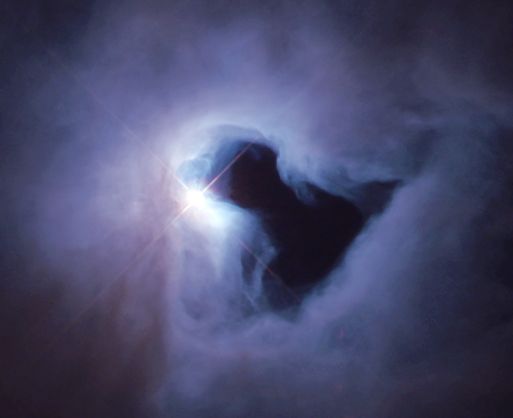Explanation: A dusty bright nebula contrasts dramatically with a dusty dark nebula in this Hubble Space Telescope image recorded shortly after December's orbital servicing mission. The nebula, cataloged as NGC 1999, is a reflection nebula, which shines by reflecting light from a nearby star. Unlike emission nebulae, whose reddish glow comes from excited atoms of gas, reflection nebulae have a bluish cast as their interstellar dust grains preferentially reflect blue starlight. While perhaps the most famous reflection nebulae surround the bright young stars of the Pleiades star cluster, NGC 1999's stellar illumination is provided by the embedded variable star V380 Orionis, seen here just left of center. Extending right of center, the ominous dark nebula is actually a condensation of cold molecular gas and dust so thick and dense that it blocks light. From our perspective it lies in front of the bright nebula, silhouetted against the ghostly nebular glow. New stars will likely form within the dark cloud, called a Bok globule, as self-gravity continues to compress its dense gas and dust. Reflection nebula NGC 1999 lies about 1500 light-years away in the constellation Orion, just south of Orion's well known emission nebula, M42.
1999 2000 2001 2002 2003 2004 2005 2006 2007 2008 2009 2010 2011 2012 2013 2014 2015 2016 2017 2018 2019 2020 2021 2022 2023 2024 2025 |
Январь Февраль Март Апрель Май Июнь Июль Август Сентябрь Октябрь Ноябрь Декабрь |
NASA Web Site Statements, Warnings, and Disclaimers
NASA Official: Jay Norris. Specific rights apply.
A service of: LHEA at NASA / GSFC
& Michigan Tech. U.
|
Публикации с ключевыми словами:
Orion - reflection nebula - bok globule - отражательные туманности - Пылевая туманность - пыль - глобулы Бока
Публикации со словами: Orion - reflection nebula - bok globule - отражательные туманности - Пылевая туманность - пыль - глобулы Бока | |
См. также:
Все публикации на ту же тему >> | |
